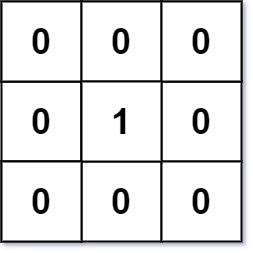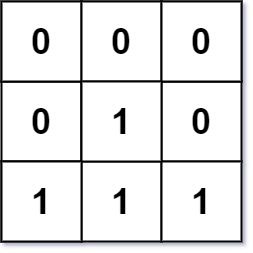Given an m x n binary matrix mat, return the distance of the nearest 0 for each cell.
The distance between two adjacent cells is 1.
Example 1:
Input: mat = [[0,0,0],[0,1,0],[0,0,0]] Output: [[0,0,0],[0,1,0],[0,0,0]]
Example 2:
Input: mat = [[0,0,0],[0,1,0],[1,1,1]] Output: [[0,0,0],[0,1,0],[1,2,1]]
Constraints:
m == mat.lengthn == mat[i].length1 <= m, n <= 1041 <= m * n <= 104mat[i][j]is either0or1.- There is at least one
0inmat.
class Solution:
def updateMatrix(self, mat: List[List[int]]) -> List[List[int]]:
m, n = len(mat), len(mat[0])
ans = [[-1] * n for _ in range(m)]
q = deque()
for i, row in enumerate(mat):
for j, v in enumerate(row):
if v == 0:
ans[i][j] = 0
q.append((i, j))
dirs = [(0, 1), (0, -1), (1, 0), (-1, 0)]
while q:
i, j = q.popleft()
for a, b in dirs:
x, y = i + a, j + b
if 0 <= x < m and 0 <= y < n and ans[x][y] == -1:
ans[x][y] = ans[i][j] + 1
q.append((x, y))
return ansclass Solution {
public int[][] updateMatrix(int[][] mat) {
int m = mat.length, n = mat[0].length;
int[][] ans = new int[m][n];
for (int i = 0; i < m; ++i) {
Arrays.fill(ans[i], -1);
}
Deque<int[]> q = new LinkedList<>();
for (int i = 0; i < m; ++i) {
for (int j = 0; j < n; ++j) {
if (mat[i][j] == 0) {
ans[i][j] = 0;
q.offer(new int[] { i, j });
}
}
}
int[] dirs = new int[] { -1, 0, 1, 0, -1 };
while (!q.isEmpty()) {
int[] t = q.poll();
for (int i = 0; i < 4; ++i) {
int x = t[0] + dirs[i];
int y = t[1] + dirs[i + 1];
if (x >= 0 && x < m && y >= 0 && y < n && ans[x][y] == -1) {
ans[x][y] = ans[t[0]][t[1]] + 1;
q.offer(new int[] { x, y });
}
}
}
return ans;
}
}class Solution {
public:
vector<vector<int>> updateMatrix(vector<vector<int>>& mat) {
int m = mat.size(), n = mat[0].size();
vector<vector<int>> ans(m, vector<int>(n, -1));
queue<pair<int, int>> q;
for (int i = 0; i < m; ++i) {
for (int j = 0; j < n; ++j) {
if (mat[i][j] == 0) {
ans[i][j] = 0;
q.emplace(i, j);
}
}
}
vector<int> dirs = {-1, 0, 1, 0, -1};
while (!q.empty()) {
auto p = q.front();
q.pop();
for (int i = 0; i < 4; ++i) {
int x = p.first + dirs[i];
int y = p.second + dirs[i + 1];
if (x >= 0 && x < m && y >= 0 && y < n && ans[x][y] == -1) {
ans[x][y] = ans[p.first][p.second] + 1;
q.emplace(x, y);
}
}
}
return ans;
}
};func updateMatrix(mat [][]int) [][]int {
m, n := len(mat), len(mat[0])
ans := make([][]int, m)
for i := range ans {
ans[i] = make([]int, n)
for j := range ans[i] {
ans[i][j] = -1
}
}
type pair struct{ x, y int }
var q []pair
for i, row := range mat {
for j, v := range row {
if v == 0 {
ans[i][j] = 0
q = append(q, pair{i, j})
}
}
}
dirs := []int{-1, 0, 1, 0, -1}
for len(q) > 0 {
p := q[0]
q = q[1:]
for i := 0; i < 4; i++ {
x, y := p.x+dirs[i], p.y+dirs[i+1]
if x >= 0 && x < m && y >= 0 && y < n && ans[x][y] == -1 {
ans[x][y] = ans[p.x][p.y] + 1
q = append(q, pair{x, y})
}
}
}
return ans
}

